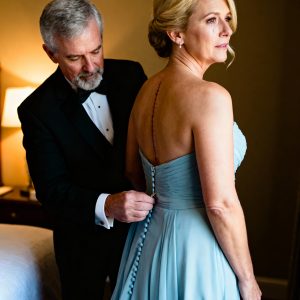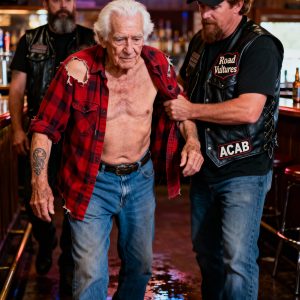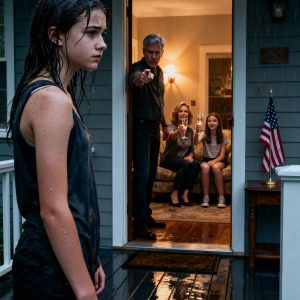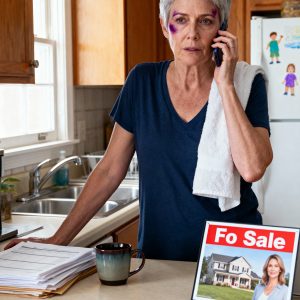The Christmas Eve I came home unannounced changed everything. I found my daughter Emma shivering on our porch in near-freezing temperatures, without even a blanket to keep her warm. That moment shattered the illusion I’d been living under and set our lives on a completely different path.
The hours that followed felt surreal. Hospital lights too bright for honest thinking. A warm blanket finally wrapped around Emma’s small shoulders. My voice explaining to a detective what I’d discovered, each word feeling like it belonged to someone else—someone who should have noticed sooner. Child services arrived with quiet professionalism, asking questions that moved at the speed of trust rather than interrogation. I signed papers I didn’t know existed, each signature a promise that this would never happen again.
When Emma finally fell asleep in that hospital bed, I sat beside her memorizing the rhythm of her breathing, as if I could learn from it how to protect her going forward.
Understanding What Had Happened
The next morning, returning to the house with the detective felt like walking through a stranger’s life. The thermostat was set to a comfortable temperature. Fresh glasses sat on the counter. The back door was locked. But there was no blanket by the porch where my daughter had been left outside.
In my former partner Rebecca’s handwriting, I found lists that organized everything except compassion. We gathered evidence—messages, posts, a box in the garage containing Emma’s confiscated belongings hidden beneath holiday decorations. Each discovery was another piece of a pattern I’d been too close to see clearly.
I called Emma’s mother, and we set aside years of disagreements to focus on what mattered: our daughter’s safety and healing. She arrived at the hospital before the coffee cooled, and together we became a united front. Co-parenting transformed from a legal term into daily action—shared schedules, coordinated decisions, constant communication. We built the framework we should have had from the start, with Emma’s wellbeing at the center of every choice.
Taking Action
I shared our story online, carefully and factually, attaching evidence and protecting Emma’s privacy. The response was overwhelming—offers of help, referrals to attorneys, support from people I hadn’t spoken to in years. I learned to let facts speak for themselves rather than dramatizing, because truth stands strongest without decoration.
Rebecca’s employer acted swiftly after reviewing the documentation, ending her contract before our meeting concluded. While their efficiency was admirable, my hands still shook because institutions can move fast, but they can’t hold a hurting child.
Through an old thread, I connected with the father of Rebecca’s former stepdaughter. Our conversation felt like two people building a bridge from opposite sides, careful and deliberate. He shared his own experiences—the charm that had curdled, the rules that always tilted unfairly, his daughter learning to apologize for simply existing. We compared notes and evidence he’d kept for years. By the end, we agreed on one thing: this time, we’d see it through to the end.
The Road to Recovery
Therapy started with crayons and silence. Emma drew houses with open doors, sometimes clouds covering the page, sometimes single lines running edge to edge like power lines carrying invisible weight. The therapist explained how trauma lives in the body and how art gives it somewhere safe to land. Progress wasn’t measured in words but in comfort—in the way Emma slowly stopped checking the room before she laughed.
Her school became a sanctuary. Teachers adjusted deadlines and watched for subtle signs. The art teacher kept the sink running warm during lunch so brushes wouldn’t hurt Emma’s hands. Classmates received guidance on kindness, and Emma found her voice standing up for another child being bullied, forming a quiet friendship in the process.
We held a community fundraiser focused on prevention and education. No one needed to hear the details of harm to understand the importance. Parents baked, kids painted banners, and we laid out resources instead of trophies. Emma watched from the bleachers, and when a classmate brought her lemonade, her wave looked like something new taking root.
Legal Resolution and Moving Forward
The legal proceedings unfolded over time. The prosecutor methodically built a case showing clear patterns of behavior. Witnesses testified with voices that shook and then steadied. When the verdict came, it felt less like celebration and more like a door finally opening in a house we’d been trapped inside.
At sentencing, statements were brief and factual, built from evidence and restraint. The judge spoke about duty and trust, assigning consequences that matched the harm. No one cheered—accountability isn’t a party. Afterward, Emma asked if we were done, and I told her we were finished with court but not with healing.
The civil case ensured Emma’s future needs would be met—therapy, education, and the ordinary expenses every child deserves. We created trusts and protections, then filed the final documents on a shelf we hope never to revisit.
Building New Traditions
We established small routines we could actually maintain. Sunday cooking experiments. A rescue cat who patrols the house. Comfortable temperature settings. Blankets easily accessible. Pancakes for dinner when we feel like it. I check the locks from habit now, not fear.
I joined a parents’ support group and said the word “guilt” out loud without falling apart. A counselor told us that love isn’t measured by what you missed but by what you do when you finally see. I wrote Emma a letter explaining the difference between explanation and excuse, keeping it in a drawer for when she might be ready.
We started helping with hotline training, standing in the back taking notes while people shared stories that reminded us why these supports matter. Each story became another reason to keep the lines open.
Creating Something Meaningful
Spring brought longer days and new opportunities. Emma began helping the art teacher, showing younger students how to draw doors that look welcoming. I framed one of her paintings—a porch with a lantern—and hung it by our front door.
We placed a bench on our porch with blankets in a weatherproof bin and a note that said “Take what you need.” The first blanket disappeared on a rainy night, proof the message worked. Emma added a drawing of a lantern to the note.
When people asked me what they should do if they suspected a child was in danger, I gave them the same advice every time: Notice. Name. Act. Keep your eyes open, say the concerning thing out loud, and take action by calling, documenting, and persisting until someone responds who can help. Keep evidence, trust your instincts, and always choose the child’s wellbeing over pride. If you’re wrong, you can apologize and learn. If you’re right, you may save a life.
Healing Continues
Quiet evenings on the porch became our norm, with blankets folded and the lantern glowing. Emma sketches while our cat pretends to hunt moths. The neighborhood kids ride past on scooters calling hello, and tomorrow holds school, therapy, dishes, and an ordinary list of chores.
We’re not a perfect family, but we’re a practiced one, and practice turns effort into rhythm. When we go inside, the door closes softly because we’ve taught it—and ourselves—how to move through the world with gentle intention.
Emma joined an art program at the community center, learning to mix colors and clean brushes without rushing. Her therapist called these weeks “integration,” and the word felt like progress you could measure in small, steady moments.
Our porch project expanded. Other neighbors created their own benches with blankets and supplies. Someone made a map calling it the “Open Door Bench Network.” The idea spread organically—not as a movement, but as neighbors helping neighbors.
Paying It Forward
I wrote guides on recognizing warning signs and taking action. Schools and community groups requested copies. A small nonprofit formed to support similar initiatives elsewhere. We kept everything transparent and simple, because sustainable help comes from systems anyone can maintain.
Emma continued growing through her art and teaching younger children. She earned scholarships, recognition, and eventually a place in a teaching program where she could turn her experience into helping others feel safe in their classrooms.
Years have passed now. Emma is thriving. The legal matters are settled. The porch bench still welcomes those who need warmth. Our home holds peace that feels earned rather than assumed.
Final Reflection
I learned that love isn’t about perfection—it’s about showing up consistently, paying attention, and acting when something feels wrong. Safety doesn’t require grand gestures; it requires daily attention to small details that add up to a child feeling secure.
The coldest night became a turning point that led us toward healing, community connection, and a life where Emma knows she is valued, protected, and free to grow into whoever she chooses to become. The porch light still comes on each evening, a small reminder that warmth and welcome can be extended even in the darkest moments.
Disclaimer: This article shares a personal story inspired by real-life experiences of parental vigilance and community support in protecting children. If you or someone you know is concerned about a child’s safety, please contact local child protective services or call the Childhelp National Child Abuse Hotline at 1-800-422-4453.





